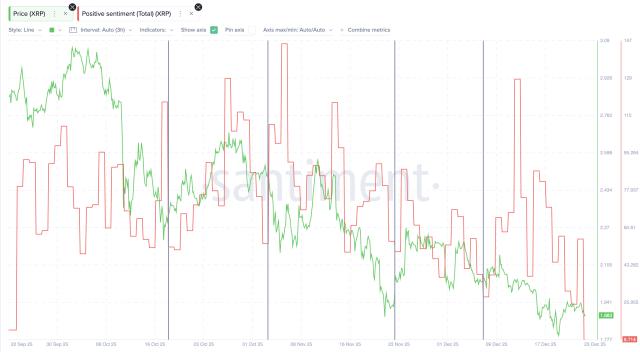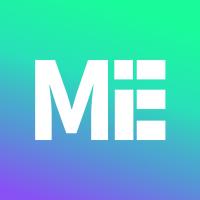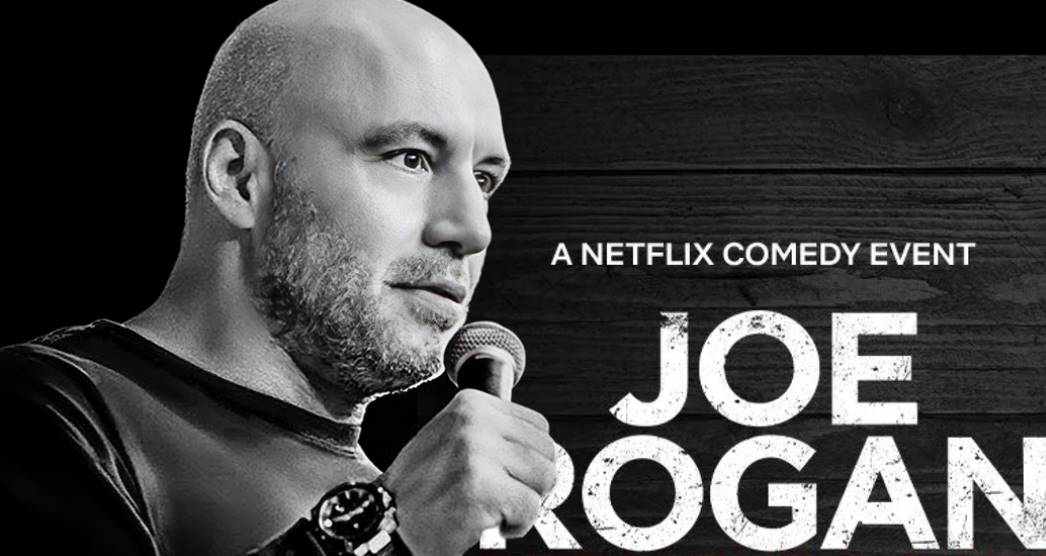Author: Cynic, LK Venture Researcher
TL;DR
- What is a full chain game?
- Challenges and solutions faced by full-chain games
- Why do you need a full-chain game?
- What chain is suitable for full-chain games?
- What games are suitable for the whole chain?
- The past of full-chain games: decentralized, trustless, let's open a casino here
- The present of full-chain games: high-performance public chains make full-chain games a realistic option
- The future of full-chain games: From full-chain games to on-chain society?
What is a full chain game?
Full on-chain game refers to a game that completely stores game logic and data on the blockchain. The operation and interaction of this game is based on smart contracts, so it can give full play to the advantages of blockchain technology, including decentralization, zero trust, verifiability, transparency and traceability, etc.
Full-chain games correspond to Partial on-chain games. Some games on the chain only store some game elements (such as game assets, transaction records, etc.) on the blockchain, while game logic and data processing still rely on traditional centralized servers.
Some games on the chain can be divided into core logic on-chain, asset on-chain and achievement on-chain according to the content of the chain.
The core logic is on the chain, which generally stores the key data and algorithms of the game on the blockchain, which can ensure its fairness and transparency. For example, putting an in-game random number generator (RNG) or battle outcome calculation logic on-chain prevents cheating and manipulation. Or by linking part of the economic system in the game to the blockchain, more diverse and innovative incentive mechanisms can be designed. For example, players can earn token rewards through mining, staking, or participating in in-game activities.
Through asset chaining, virtual items, characters or other resources in the game are usually expressed in the form of non-homogeneous tokens (NFTs) or homogeneous tokens (FTs), allowing players to own, trade and manage these assets, Provide players with economic benefits and encourage players to participate in the construction of the game ecosystem.
Achievements on the chain usually means that players unlock certain achievements in the game, and they can choose to register them on the chain as a proof of their game level or as a certificate for subsequent AirDrop, but they cannot be traded directly. Compared with asset on-chain, achievement on-chain has much less economic incentive for players, but it also brings the game back to its essence. "No matter how you say it, the most important thing about games is fun."
 Game types defined according to the degree of chaining
Game types defined according to the degree of chaining
Challenges and solutions faced by full-chain games
The concept of full-chain games has not been adopted on a large scale so far. LK Venture concluded that there are many problems in reality:
1. Performance and expansion issues: The processing capacity of the blockchain network is relatively limited, especially in terms of transaction throughput and confirmation speed. Full-chain games may cause network congestion and delay, affecting the game experience. To solve this problem, developers need to research expansion solutions, such as sharding technology, state channels, and layer-2 expansion.
2. Transaction costs: Every operation in the full-chain game needs to be submitted to the blockchain as a transaction, so there will be a corresponding handling fee (such as the Gas fee of Ethereum). If transaction costs are too high, it may limit player engagement and game playability. To reduce transaction costs, methods such as optimizing the transaction structure and using more energy-efficient consensus algorithms need to be considered.
3. User experience: Compared with traditional games, full-chain games may face challenges in user experience. For example, users need to understand and use cryptocurrency wallets, handle private keys and transactions, etc., which may have certain thresholds and learning costs for ordinary users.
4. Privacy issues: Due to the open and transparent nature of blockchain, player data and transaction information in full-chain games may face the risk of privacy disclosure. Protecting player privacy requires the use of technologies such as Zero-knowledge Proof and privacy computing, but these technologies may further increase the complexity and development costs of the system.
5. Game design limitations: Due to the performance limitations of blockchain technology, full-chain games may not be able to achieve complex game mechanics and real-time interaction. This means that full-chain games may be limited in terms of game types and gameplay, and it is difficult to adapt to high-performance game types such as massively multiplayer online games and action games.
High-performance Layer 1 and Layer 2, which has been in the limelight recently, are expected to reduce transaction costs, increase confirmation speed, and alleviate problems 1 and 2 well.
Account abstraction AA can lower the threshold for users and solve problem 3. ERC-4337 has passed the audit on March 2, 2023 and has been deployed on the Mainnet. The large-scale use of account abstraction is just around the corner.
The Zero-knowledge Proof technology has been proved to be able to protect privacy well and solve problem 4. As for question 5, do we really need to chain all types? The answer is probably no.
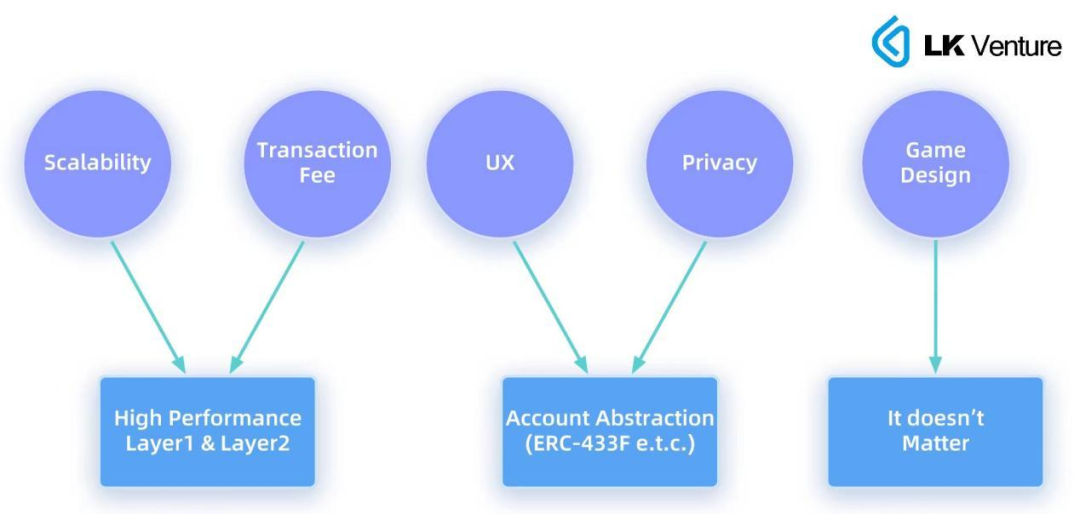 The main challenges and solutions faced by the whole chain game
The main challenges and solutions faced by the whole chain game
Why do you need a full-chain game?
There are still so many problems in the full-chain game, why do we need the full-chain game? This question is somewhat like asking, why do we need a permissionless blockchain?
LK Venture believes that the market demand for full-chain games can be understood from the following aspects:
1. The decentralized game world is open to everyone: the full-chain game eliminates the dependence on the centralized server, making the game run more decentralized. This can increase the security and censorship resistance of the system and reduce the risk of dependence on a single organization or individual.
2. Trustless, verifiable game fairness: Since game logic and data are stored on the blockchain, game rules and status are transparent to everyone. This enables players to verify the fairness of the game and the correctness of the results, increasing the credibility of the game.
3. Not only the right to use, but also ownership: full-chain games can use non-fungible tokens (NFTs) to represent items and characters in the game, enabling players to truly own and control these assets. This kind of ownership can incentivize players to participate in the game, while providing them with real world value and benefits.
4. Once on the chain, run forever: Since the game state and logic are stored on the blockchain, the full-chain game has high sustainability. Even if the original developer of the game no longer supports the game, as long as the chain does not stop producing blocks, the game can still continue to run and develop.
5. Rely on the community and contribute to the community: Full-chain games realize community-driven development and governance through smart contracts and decentralized autonomous organizations (DAOs). This allows the game to better adapt to player needs and market changes, increasing the life cycle and attractiveness of the game.
6. Open collaboration, user creation makes the game evolve iteratively: open source code and open system promote open collaboration among individuals. With the assistance of the AI model, the creative vitality of users will be fully released, and the content of UGC or AIGC will be fully released. Bring more diverse, richer and more exquisite game experience.
 Analysis of market demand factors for full-chain games
Analysis of market demand factors for full-chain games
What chain is suitable for full-chain games?
LK Venture compares TPS, confirmation time, transaction cost, security, independence, etc., and draws a five-dimensional diagram with a full score of 5.
 Comparison of the parameters of the main public chain infrastructure of the whole chain game
Comparison of the parameters of the main public chain infrastructure of the whole chain game
The first premise of a full-chain game is excellent transaction performance, a short confirmation speed can bring a better game experience, a good ecology can provide supporting infrastructure for the game, security is crucial to protecting game assets, and independence is Ensure that the game is not affected by other events on the chain and cause network congestion.
There is no silver bullet in the real world, and various solutions have their own advantages and disadvantages. Game projects can be selected according to their own design characteristics.
What games are suitable for the whole chain?
LK Venture believes that full-chain games should take advantage of their full-chain advantages, rather than simply migrating the operating logic to the chain. In other words, the whole chain should not be for the sake of the whole chain, the whole chain is not an end, but a means.
What types of games can take advantage of the blockchain? There are two types that LK Venture considers most suitable.
One is an open, transparent, and verifiable multi-party game (Multi Party Game, MPG) using the blockchain. The interesting point is that Game can be used as both a game solution and a game solution.
Multi-party means that the game is not stand-alone, not the interaction between people and the fixed game logic, but the interaction between people. The permissionless blockchain allows everyone to have the opportunity to participate in the game.
The game means that all parties are confrontational. Through the whole chain, we guarantee the fairness of the game. The openness, transparency and verifiability of the blockchain make it impossible for game designers to tamper with the results.
The most direct MPG is gambling, and when it is extended, all kinds of chess and card games and turn-based strategic games can also be classified as MPG. The characteristic of MPG is that the number of interactions is relatively small, and it tests the player's thinking ability rather than reaction speed. The antagonistic parties obtain a fair ruling through the blockchain.
The other is an open, autonomous, and proprietary user-generated game (User Generated Game, UGG) using the blockchain.
In this type, the original designer of the game only sets the minimum core rule set, and users can use their imagination and creativity on the basis of the core rule set to explore various types of gameplay. With the blessing of the AI model, users can more easily put their creativity into practice, and obtain the benefits of their creativity from the confirmation of blockchain rights.
There is no centralized organization anymore. On UGG, there is only the union of individuals and individuals. The real autonomy is to distribute governance rights to everyone, which is the most extensive democracy. If you are not satisfied with the core rule set of the original designer, you can of course modify it at any time and deploy a new contract to become a new world.
Starting from the smallest seed, under the blessing of the positive feedback flywheel, the game will eventually grow into a towering tree.
The past of full-chain games - a decentralized, trustless gaming market
On November 1, 2008, Satoshi Nakamoto released "Bitcoin A Peer-to-Peer Electronic Cash System". On January 3, 2009, the Bitcoin genesis block was born. As bitcoin transactions became more widely known, people started using it for online gambling. In 2012, the first Bitcoin-based gambling game - SatoshiDice appeared.
SatoshiDice is a simple gambling game based on the Bitcoin blockchain. Players send Bitcoin bets to the game, and the game will return the winning or losing result according to the pre-set odds and random number generator. At this stage, blockchain gambling games are mostly confined to the Bitcoin ecosystem with a limited variety of games.
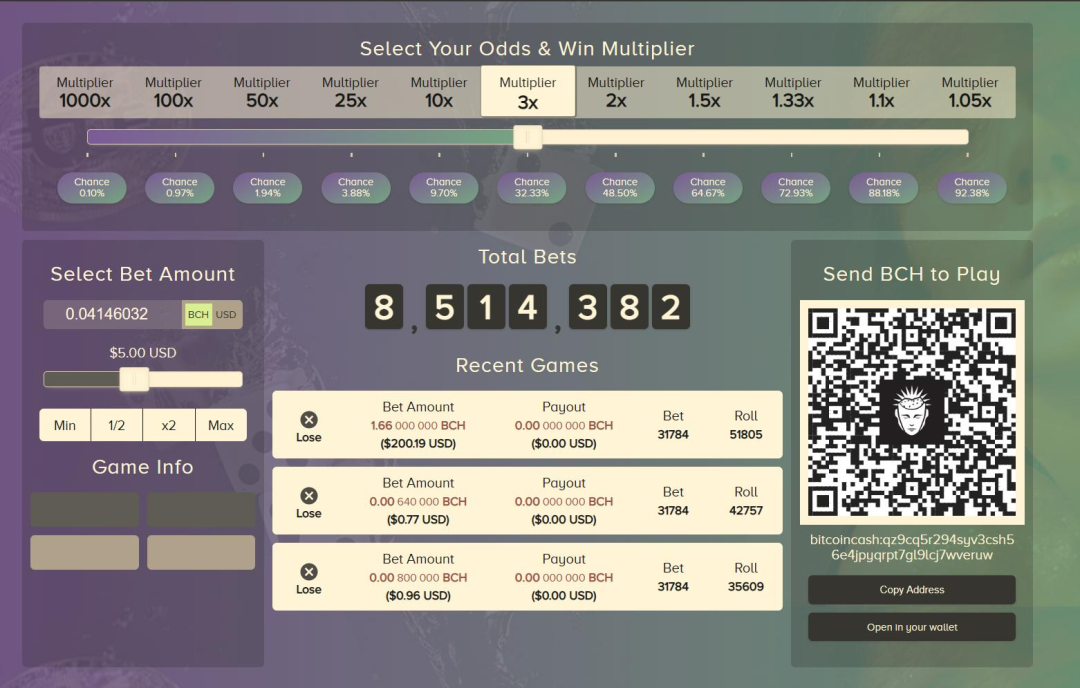 Screenshot of Satoshi Dice game homepage
Screenshot of Satoshi Dice game homepage
In 2013, the Ethereum (Ethereum) project was launched, and its smart contract function had a major impact on blockchain gambling games. In 2015, the Ethereum mainnet was launched, and blockchain gambling games began to transfer from Bitcoin to Ethereum. Using Ethereum's smart contract technology, developers can create more complex and interactive gambling games. At this stage, many gambling games and platforms based on Ethereum have emerged, such as vDice, Etheroll, etc.
In May 2014, Kevin McCoy and Anil Dash created the first known NFT. In 2017, CryptoKitties, as the first Ethereum-based non-fungible token (NFT) game, successfully attracted a large number of users. NFT technology has had a profound impact on the development of blockchain gambling games. NFT can be used to represent unique assets in games, such as limited-issue gambling props or virtual tokens, and more and more gambling games are beginning to use NFT technology.
In the summer of 2020, DeFi Summer broke out, decentralized finance (DeFi) began to rise, and blockchain gambling games entered a new stage of development. Gambling games have begun to integrate with DeFi projects and platforms, providing players with richer financial functions, such as Yield Farming, staking, and lending.
At the same time, the public chain track exploded, and public chains such as BSC, Polygon, Solana, and Tron optimized the transaction cost of Ethereum to provide players with a faster and cheaper transaction experience.
In the process of the gradual maturity of the blockchain gambling game market, some innovative game types and gameplays have also emerged. For example, prediction market platforms such as Augur and Gnosis allow players to place bets on the outcome of future events. These platforms use smart contracts and blockchain technology to achieve a fair, transparent and trustless gaming environment.
The gambling game is actually the first game on the blockchain. It is naturally full-chain, because comparing the size and guessing numbers are nothing more than mathematical calculations, and verifiability can be achieved through a simple hash function. Taking history as a mirror, we can know the ups and downs. Although most people have a bad impression of gambling, one should not forget that the whole chain of games started here.
The present of full-chain games - high-performance public chains make full-chain games a realistic option
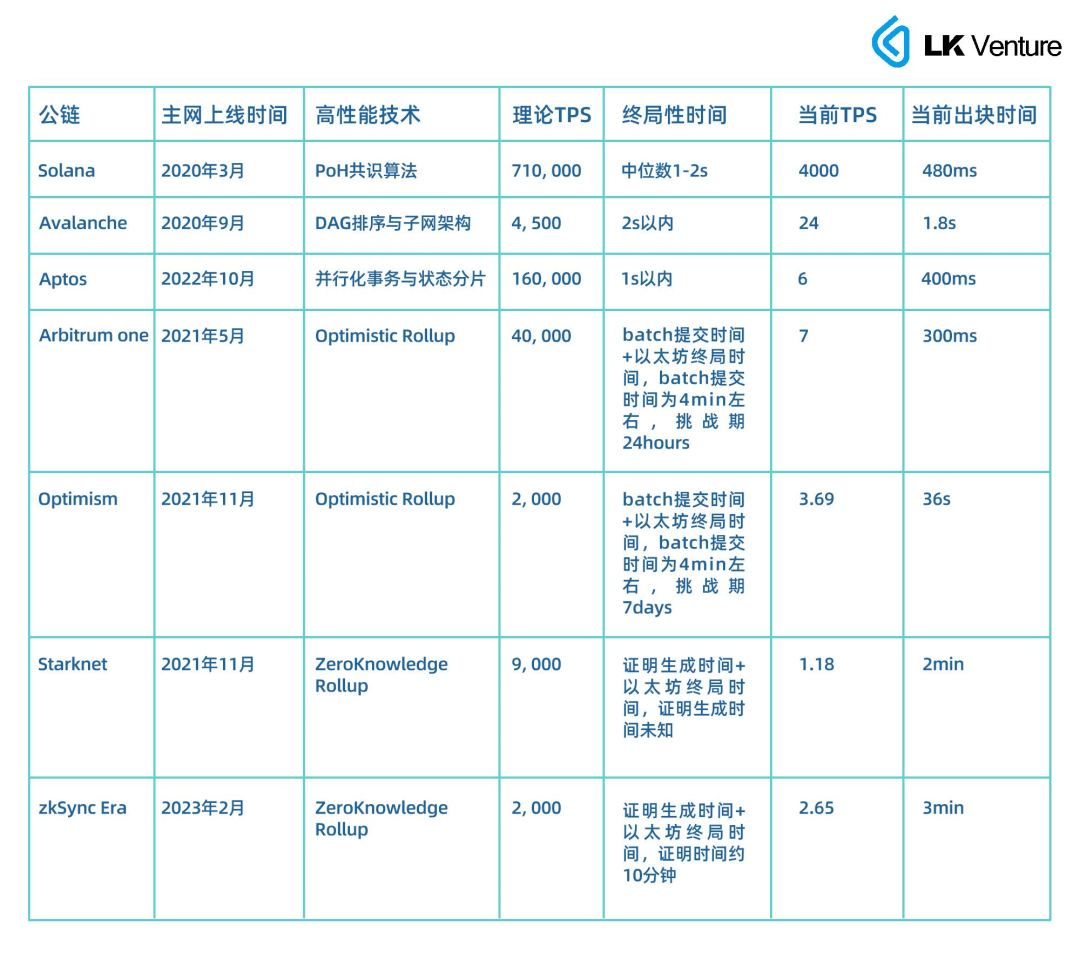 Comparison of some high-performance public chains
Comparison of some high-performance public chains
With the rise of various high-performance Layer 1 and Ethereum Layer 2 expansion solutions, full-chain games gradually have a realistic basis for feasibility. People's exploration of full-chain games has also deepened, and the appearance of the Dark Forest game can be regarded as a milestone event in the development history of full-chain games.
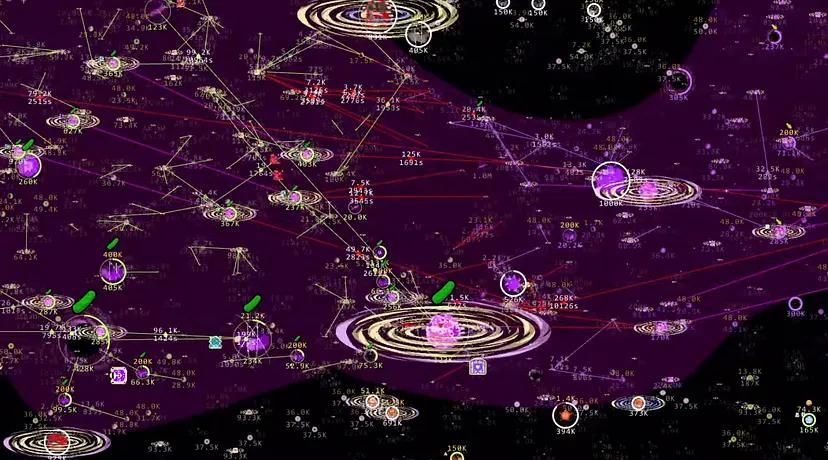 Dark Forest game screenshots
Dark Forest game screenshots
Dark Forest is the first incomplete information game on the entire chain. It not only utilizes the open, transparent and verifiable attributes of the blockchain, but also uses ZK-SNARKS technology to hide the information that affects the game experience, realizing the game of incomplete information. The environment of the dark forest in "Three-Body Problem" is restored on the chain.
As an open MMO strategy game, Dark Forest encourages players to create their own gameplay inside and outside the game, and thus a huge community ecology was born. Some people joined forces to set up a trade union organization, and made great achievements in plug-in development, game exploration, and event planning. huge contribution. As a real-time strategy full-chain game, every interaction of players is presented on the chain through contract calls, and is updated in real time between different players. The "fog of war" realized by ZK-SNARKs technology is realized by shading the player's vision The incomplete information game is simulated in the dark forest environment.
Dark Forest has proved the feasibility and playability of full-chain games through facts. Since then, the door of full-chain games has really opened.
All major public chains are cultivating a full-chain game track, but the most active one should be Starknet. On Starknet, a variety of full-chain games such as LootRealms, GO L2, Isaac, Unstoppable Games, etc. have emerged, and they are all in the limelight. However, considering the current high Gas Fee of Starknet, the launch of the mainnet of the game is still far away.
Judging from the current overall trend of various game projects, there are two game themes, one is a strategic battle game similar to Dark Forest, and the other is a casual game that highlights financial attributes. Considering the current high Gas Fee, only real economic incentives can make people participate in the game. From this point of view, the latter will be launched on the Mainnet faster.
The future of full-chain games—from full-chain games to on-chain society?
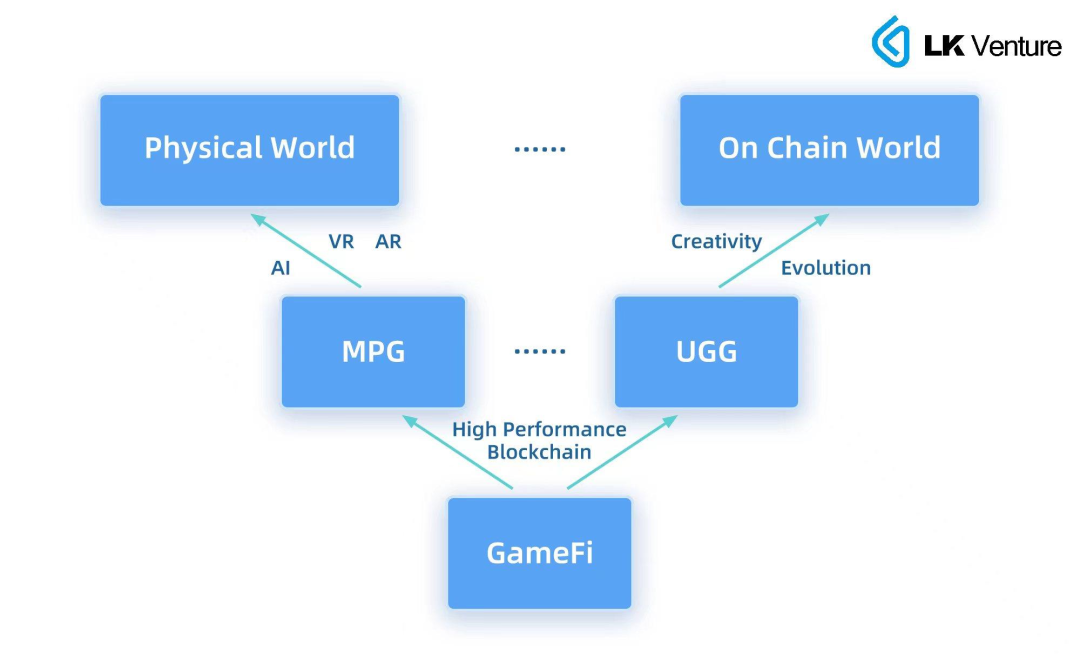 The evolution map of the whole chain game ecology
The evolution map of the whole chain game ecology
In the short term, the Ethereum expansion plan headed by Rollup still plays a limited role, and anchoring on Ethereum will be negatively affected by other financial activities on Ethereum (for example, when the price of the encryption market fluctuates greatly, the MEV robot Attacks lead to a sudden increase in Gas), the cost is still too expensive for more complex full-chain games, and it is difficult to acquire users based on game experience alone. However, due to its incompatibility with EVM, the high-performance Layer 1 has a limited number of developers and does not have a huge user base.
Therefore, in the short term, GameFi, which brings higher economic incentives to players, may still dominate.
In the medium term, we believe that the unipolar status of Ethereum will be broken, and more high-performance Layer 1 will attract a large number of users due to lower costs and better experience. The technology of ZK- Rollup will be more mature and truly reduce the Gas fee to the transaction level of the traditional world. More customized private chains will appear to avoid network congestion caused by irrelevant time. On this basis, various complex full-chain games will be truly deployed to the Mainnet, and more possibilities of full-chain games will be explored in practice.
In the long run, games start from entertainment, but may have real value. The interaction records of each player in the game and the game process may be used as materials to train AI to feed back real life. The blockchain confirmation allows each user to control their own data and gain benefits from the interaction on the chain. For example, the response of players in racing games can better train the autopilot system, at least providing many boundary conditions that are difficult to appear in real life. The emergence of UGG will make the game gradually move closer to the social ecology.
After all, human society is also gradually established under a set of core natural laws through exploration and creation among individuals. Who can say that social ecology cannot be developed on the chain?
|About LK Venture
LK Venture is an encryption investment and research institution under Linekong Interactive (08267.HK) focusing on the Web3 field. It was formerly known as Consensus Lab (Consensus Lab). Invest in more than 100 projects from North America, Asia, Europe and other countries and regions, such as FTX, Polkadot, Filecoin, Casperlabs, and Coin98.




